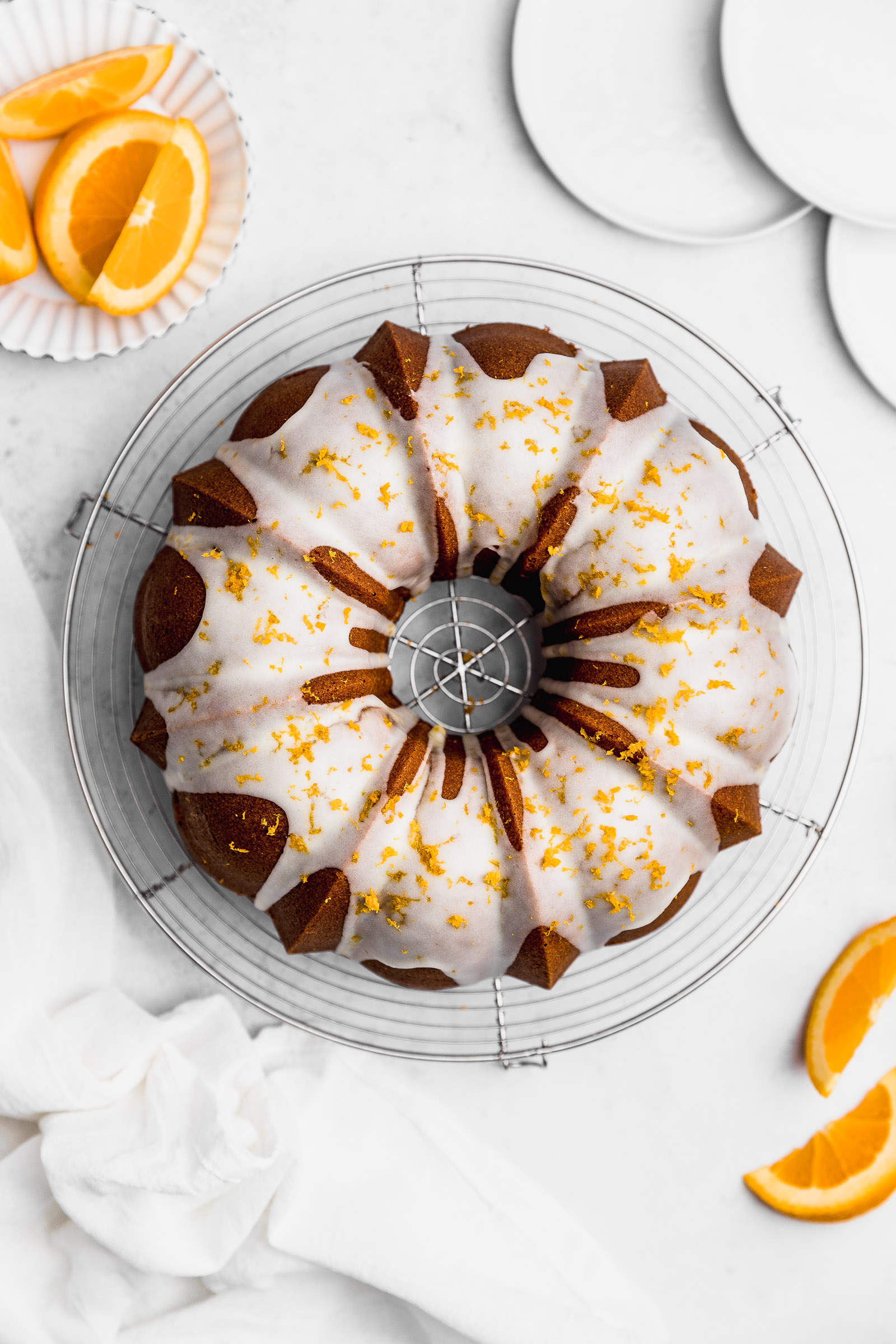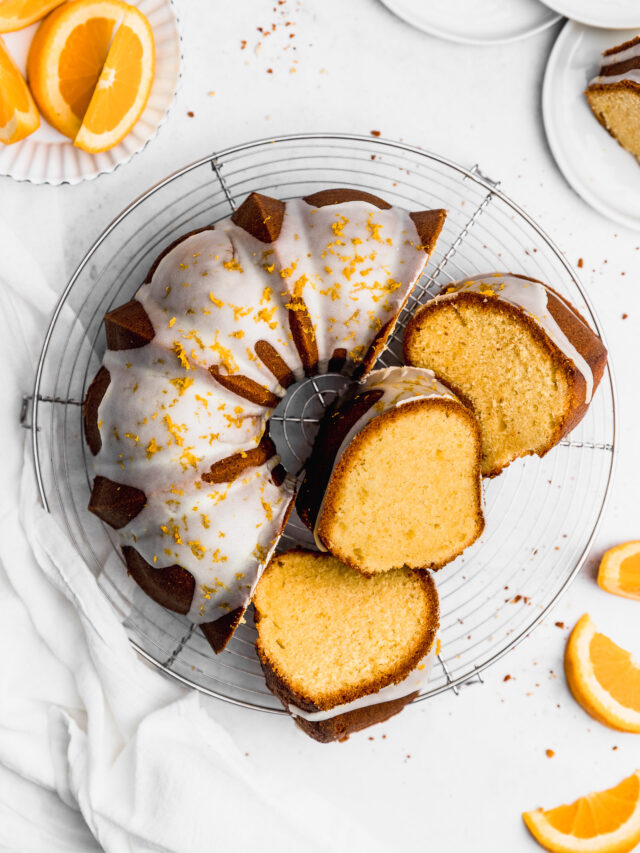Orange Bundt Cake has got to be one of the best Bundt Cake flavours in the world. Just the smell as it’s baking is wonderful, and then you have that lovely crumb that’s the best thing you can have. The recipe is simple and the result is moist, tasty and perfect for any occasion.
How to Make an Orange Bundt Cake
To make an Orange Bundt cake, the first thing we need to do is to cream the butter, oil, sugar and orange zest. “Creaming” is the name of the method when you beat the butter with the sugar to make it soft and fluffy. This can be achieved using a whisk or an electric mixer. Then we add the eggs and beat again until the mix thickens. Finally, you add the orange juice, milk and dry ingredients to bring the batter together. We then bake the bundt cake, release it from the pan and finish with a delicate glaze.


Where does the orange flavour come from
Many people think that the flavour in an Orange Bundt Cake comes from the orange juice in the recipe. It’s partly true. In reality, most of the orange flavour and that characteristic aroma comes from the orange zest. In the orange’s skin, there are lots of oils. When you rub the zest with the butter and sugar and then while baking, they release a lot of flavour and aroma. The same thing happens in a Lemon Bundt Cake, where that amazing smell and classic taste depends a lot on the zest. Therefore, I recommend that you use a good quality zester and don’t skip adding it to your cakes.
How to get a fluffy and moist cake
This is one of the questions I get asked most often about cakes. This Orange Bundt Cake is fluffy and moist for a few reasons:
- Moist: The moisture in a cake comes from the fat in the formula. In this case, we use butter and a bit of oil as well. That bit of oil really helps the mouthfeel of the crumb. It has a higher evaporation point than butter, which means it will never leave your cake. Now, you also want to be careful and not over-bake your cake to prevent it from drying out and burning.
- Fluffy: This Orange Bundt cake is fluffy because of the beating we use at several points of the recipe. First, we beat the butter and then we also do it when adding the eggs. The other ingredient that helps is baking powder which generates air when baked. This air that is generated is then trapped by the gluten in the flour. It creates a sort of web structure that gives the cake its airy texture.

How to prepare the Bundt Pan
As with many things in the kitchen, there are many ways to prepare a bundt pan before baking and the same goes for methods for releasing the cake from the pan. If you don’t have one that works for you currently, I can give you the method that works for me. For my bundt cakes, I like to brush the interior with melted butter and then flour it evenly. To prevent the cake from forming an opaque layer on the outside, turn it around and tap it against the table to release excess flour. Once it’s ready, I like to release it from the pan as soon as it comes out of the oven. Many pan brands recommend waiting 10 minutes before releasing it. Personally, I like to do it as soon as they come out of the oven. If you want to see the bundt pans I like, they’re all in my Amazon Storefront.

Common Mistakes
In my 8 years of sharing recipes (and many Bundt Cakes), I’ve seen a few errors repeated commonly. To prevent any of these from happening to you when you make this Orange Bundt Cake, here are a few of the most common:
- Glaze: Always, always, wait for your cake to cool down completely before glazing it. This applies if you want the glaze to be white when it dries down. If the cake is even slightly warm, it will melt on it and go translucent.
- Gluten-free: There are some good gluten-free replacements nowadays for wheat flour (my favourite being Bob’s Red Mill 1:1). However, not all gluten-free flours can be used interchangeably with regular all-purpose wheat flour. You can’t use almond flour, oat flour, quinoa flour or other similar. This is because the result will look like a bread pudding with no air inside. Gluten is the structure that holds the air inside!
- Waiting for the cake to cool before releasing it from the pan: Many times, if you wait for the cake to cool down completely before releasing it, it will stick. Condensation forms between the cake and the pan. That could make it stick or maybe little bits of it does. That’s why I rather release it from the pan as soon as it comes out of the oven. Maximum, I’ll wait 10 minutes.
- Checking if the cake is done: Sometimes when we test a cake for doneness with a skewer or a thin knife, we insert it and remove it too quickly. This doesn’t give the batter a chance to stick to it. Ideally, you want to insert it, wait 3 seconds and then remove it. If you’re insecure, I recommend that you use a serrated knife. The crumbs can stick to the teeth of the knife and you can check if it’s raw or not.

Other Bundt Cake Recipes
Now that I know that you love a good Orange Bundt Cake, here are a few other delicious Bundt Cake recipes (my favourite, too!) that you can make when the craving hits:





Orange Bundt Cake Recipe
Ingredients
For the Orange Bundt Cake
- 180 g unsalted butter at room temperature
- 50 g olive or vegetable oil
- 2 oranges zest only
- 340 g granulated sugar
- 4 eggs
- 120 ml milk of any kind
- 120 ml orange juice freshly squeezed
- 2 tsp salt
- 2 tsp baking powder
- 400 g all-purpose flour
For the glaze
- 200 g icing sugar
- 3⅓ tbsp orange juice freshly squeezed
Instructions
For the Orange Bundt Cake
- Beat the butter with the sugar, zest and oil until the mix becomes lighter in colour. You can do this with an electric mixer or using a hand-held whisk.
- Add the eggs and beat them again until they are fully incorporated and the mix looks airy. From all the beating, the mix should thicken and start to unstick from the sides of the bowl.
- Add the milk and orange juice and mix. It will look split but don't worry. It will come back with the flour.
- Add the flour, salt and baking powder and incorporate using a spatula.
- Grease your bundt pan with melted butter. You can paint it onto the pan or use a piece of kitchen paper to spread it around. Flour the pan. After distributing the flour around the inside of the pan, turn it upside down and pat it to remove the excess.
- Place the batter inside the pan and spread it out.
- Bake the cake at 180°C/350°F for 45min-1hour or until when you insert a knife, it comes out clean. It's important to not overcook it to prevent it from drying out. If you have an electric oven, check the cake at the 30-minute mark. If it's golden enough on top, change the heat source to only the bottom.
- Right after it comes out of the oven, turn the pan over onto a cooling rack. Lift the pan off the cake carefully, and allow it to cool completely.
For the glaze
- Slowly add the orange juice to the icing sugar, mixing constantly with a whisk. Once you like the consistency, stop adding juice.
- Make sure that the bundt cake has completely cooled down before glazing. Once it had dried, I finished it with extra orange zest.


